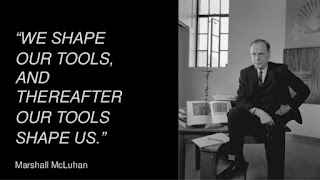How webs of meaning grow and change
post by Hazard · 2020-08-14T13:58:38.422Z · LW · GW · 0 commentsContents
The Place of Purpose Objects that Want Meaning Webs Meaning and Intent Connecting past intent to current interpretation Automatic vs Intentional None No comments
The Place of Purpose
The world of design has this word "affordance" which I really like. To oversimplify, the affordances of an object are the potential uses that it is particularly apt for. A glass jar doesn't really afford being able to write, but a pencil does. Affordance is a really useful idea to contrast with that of purpose.
Anything that is designed has a purpose, an intended use case conceived of in the mind of the designer. Though it makes total sense to say that things have purposes, it's important to not forget that purpose is a relationship between a designer and the object. What's cool is that the purpose of any object is always going to be a subset of what that object affords. Chairs are for sitting, but they also are great for standing on to change a light bulb. Yes, that's what a step-ladder is for, but there are no purpose goblins that will prevent you from using a chair instead.
Condoms were not made to be used for sous vide, and yet...

No matter what purpose you build with, as soon as you create anything it gains its own independent existence. Purpose becomes a historical artifact, not an ongoing control loop that mediates the object's relation to world. If you're a coder, you are already intimately familiar with the difference between what you intended your code to do, and what it actually does.
If you want people to use an object in accordance with its purpose, you've got two main paths. The first is to do better design. Peak design is when you create something with affordances that are aligned with your intended purpose. Think of it as a potential "first mover advantage". There is no metaphysical tether from the historical purpose to the current user, and yet if you design cleverly enough you can almost build the purpose into the affordances of the object.

The other option is to ask. Ship your product with an instructions manual. Tell users what to do. Create an ongoing relationship between the designers and the users. You can be more or less of an ass about this. You could rudely demand "THIS IS WHAT THIS IS FOR AND YOU BETTER USE IT THIS WAY OR ELSE!" As it turns out, asking works surprisingly well. Anyone reading this post has grown up in a world almost completely composed of products that were designed by someone for a purpose, and we've been trained to sniff out that purpose when using things. When things are designed well, this habit of seeking out something's purpose and act in accord with it is a short-cut to discovering a products best uses. But this habit can also get in the way. We are so good at hunting for purpose that merely knowing what something is supposed to do can blind us to what it could do.
Objects that Want
To really get into the mood and embrace this wide conception of affordance, I like to personify objects. Everything is alive and wants to be used in particular ways. Think of books like What Technology Wants or the quote:
On the one hand information wants to be expensive, because it’s so valuable. The right information in the right place just changes your life. On the other hand, information wants to be free, because the cost of getting it out is getting lower and lower all the time. So you have these two fighting against each other.
This isn't just a claim about what we should do with information. It's about what sort of thing information is, what it naturally pushes towards, how it wants to be used. It's almost an Aristotelian telos view of the world, if you replaced everything having singular final objective/goal with everything having a multiplicity of strange-attractors that they moved towards.
The telos of a product is the on-the-ground reality that you actually interact with. It affects you more than purpose. Once an object is in your hand, purpose can only (sometimes) offer you insight into the telos of an object. That's another way in which affordances are wider than purpose; everything, whether it's natural or designed, has a telos. Only things that are designed have a purpose. Waves were not designed, but they still want to be surfed.
Meaning Webs
Time to take everything we've talked about with affordances and port it into the world of symbols and meaning. Though I am talking about a fairly expansive sense of meaning, I'm not talking about the sort like "I don't find working my 9-5 meaningful". More the "what does this mean?" sense. I'm going to outline intention as a subspace of meaning in a way that parallels purpose and affordance.
But first I need to circle back to affordances to add details to something I oversimplified. Here's a richer definition of affordances:
An affordance is a relationship between the properties of the object and the capabilities of the agent, which determines just how the object could possibly be used.
Specifically, affordances are contextual to the users. They aren't something that can be described in the "value-neutral language of physics". There is always an audience in mind, and the question is what does this object afford this audience. Pencils afford writing for humans, but not for ants.
Similarly, meaning does not exist in a vacuum; something has to mean something to someone, and there can be different meanings for different someones. “Nur Bahnhof verstehen” means something to people who speak German, and it means very little to me (I didn't even look up its translation). Starting a tweet with "I am giving back to the community!" will only have special meaning to you if you were paying attention at a very specific point in time.
The nature of meaning extends beyond the existing mapping I've made to affordance. Not only is the meaning of something a private matter, within a given person the meaning of anything is contingent on the meaning of its present and historical context. The meaning of any word in a sentence is shaped by the meaning of the sentence as a whole. It's this contextual/relational nature of meaning that lets you pick up the meaning of words you're unfamiliar with. Before you learned any language, your understanding of the situation you were in shaped how you attached meaning to the strange yet structured sounds the Big Ones kept making at you. It is from being embedded in a complex network of the rest of the universe that things have their meaning.

Isn't it circular logic to say that "meaning is contingent on the meaning of the context" (what grounds the meaning of the context?). Not really. It's more a mutually causal dynamical system that iteratively approaches equilibrium. Popularity is an example: one's popularity is contingent on the popularity of everyone you're friends with. Google's page rank is a great technical example. The rank of any given page is based on the rank of all the pages that link to it. Though I don't expect to directly use the page rank algorithm to usefully parse meaning, it helps me sleep at night to know there is robust technical grounding for understanding these sorts of mutually causal constructs.
Tying back into the affordances view, there is no single free-of-perspective meaning web, but a vast ocean of possible meaning webs, sourced in everyone's unique history with reality. When I'm feeling particularly Platonistic I imagine one grand meaning web that everyone only ever sees a slice of. Though if such a web was really broad enough to contain "all possible perspectives", most of it would be incomprehensible mathematical wilderness [LW · GW] that doesn't and could never mean anything to humans. So I stick with imagining a ocean-like distribution of individual meaning webs, ones that will frequently have huge structural overlap between people despite all being unique.
Meaning and Intent
Meaning is to affordance as intention is to purpose. Just as all objects have their own affordances, but only some have a purpose, everything conveys meaning, but only some of that meaning is intentional.
Communicating with intent is like designing with purpose, and both are the domain of agent-like [LW · GW] things. Intention exists in the mind of the speaker. As I'm writing, I'm trying to craft a post that networks into your web of meaning in the way I want it to. This intention is very important to me, but it's not something that lives in the words. Once this post is written, its connection to my intent is historical and you will extract meaning from it how you will.
The intention of any act of communication is always more narrow than the entirety of the meaning it conveys. This is the idea behind The Death of the Author. A novel is always embedded in a much richer web of meaning than just the authors intent. I bet this is how you already interact with old propaganda posters:
Their intended message, "these people are your enemies, they are evil, be afraid and work hard" is narrow and straight forward. If you go beyond the intent, these posters are a wealth of information about the implicit assumptions of the culture they were made in. All acts of communication always leak more information than intended.
Connecting past intent to current interpretation
Like the shift from the designer to the user, we shift from the speaker to the listener. Separating "what I meant" from "what this can mean". This will feel much weirder for communication than it did for objects. Isn't the whole point of language/communication to transmit my intent? To get across what I mean? Death of the author is cool and all, unless you're the author, cuz now you're dead :(
These are important intuitions. There are good reasons that people are even more attached to the intent of their communication than designers are to the purpose of their creations. What I want to explore is analogous to what we saw with purpose: as soon as an act of communication is made, it has its own reality independent of its creator. Words don't carry with them an error-correction mechanism that links it to the intent. By default the relationship between a words and intent is a historical one.
If you want to ensure that people extract the meaning you want them to from your communication, you have two main options. The first, again, is good design. Learn other people's webs of meaning. Study what language makes who think what in which contexts. Do the upfront work of creating something so well crafted it can't help but be interpreted the way you want.
The other option is to ask. You can do this nicely: make a brief tweet, but also link to a much longer blog post so someone can better understand what you mean, add qualifiers and epistemic statuses, keep rerouting people to the clearest articulations of your intent. You can also do this rudely. Insult anyone who misinterprets you. Loudly declare you'll pick a fight with anyone who clips you out of context.
Besides mapping onto "who's responsible for putting in the effort?", these different takes have roots in the different mental processes we use to construct meaning
Automatic vs Intentional
When you watch a movie, say Sean of the Dead, the dialogue of the characters, the visuals of the set, and the soundtrack all instantly evoke different thoughts/feelings/emotions/cognitive-schemas etc. You construct a lens of meaning to understand the film through without even trying. This automatic construction of meaning can't be turned off. At best you can turn your attention to something more engrossing to process.
This automatic process, through some opaque wizardry, combines the current context with an amalgamation of all your past learnings and experiences to produce some meaning. This is where the web of meaning goes from an abstraction to a cognitive reality. At first it may seem puzzling how this can fit in your head. Clearly, meaning in the present is shaped by the entirety of your past, but how could that much data fit in your mind, and how could it be processed at speeds that allow you to have a fluent conversation? This is where I find it useful to switch metaphors, from a web of meaning, to a geological landscape of meaning. Over your life, experience flows across the surfaces of your mind like water through a canyon. Your mind still bears the contours carved into it by old flows of experience, even when the explicit memories of past encounters have been lost to time. The statue does not remember the chisel, yet it bears the cumulative effects of every stroke.

This is part of what makes automatic meaning processing so fast while still being so capable. All of the "intelligence" of the automatic is encoded in the highly structured channels that have been carved. It takes time and effort for these structure to be shaped in a useful way, but once they are made it's effortless to use them, like water flowing through a canyon. It also reflects the way in which a mutually causal construct like meaning is built up iteratively over time.
This automatic extraction of meaning is augmented by our ability to intentionally extract meaning. If I want, I can reread "The Road Not Taken" by Robert Frost a few times and really mull over what it's about. I can reflect on my implicit web of meaning, make it explicit, and take a guided walk, making connections that didn't exist in the implicit version. After some intentional pondering I might realize that contrary to my first impression that the poem was about proudly being non-conformist, it's actually about feeling a melancholy curiosity of what would happen if you'd made a different decision.
As with many things, the predictive processing paradigm gives ideas about when you might expect to see intentional or automatic processes being engaged. The default state of a human who is awake seems to be automatic. Intentional processing of meaning only happens when there is bottom-up surprise, or top-down focus. I feel comfortable assuming that most people, most of the time are using their automatic meaning processes to interact with the world.
(Note: don't map automatic and intentional onto naive conceptions of "thinking fast and slow" or "the rider and the elephant". I reject that automatic meaning extraction is "fast but biased" and intentional is "slow but rational". Kaj Sotala [LW · GW] does a great jump exploring why you might want to move past that paradigm)
(aside: a thing I don't like about the geological metaphor is that the mind is a lot more malleable than rock. A river shaping a canyon is mostly a subtractive process, but experience shaping your brain adds, subtracts, stretches and smooshes)
With the distinction between automatic and intentional meaning construction, we can better understand how to maintain your intent. Asking people to focus on your intent is an effort to engage conscious/intentional meaning processes. There's more wiggle between your intent and the meaning others will automatically construct, so you request they go through a conscious process of hunting for your true intent.
The route of better communication design is one of taking other's meaning webs as is (both intentional and automatic) and taking responsibility to choose the right words.
There is a third, sneakier option and it's the motive force behind why I wrote this post in the first place. Think back to how automatic meaning works. The canyons that govern the automatic are shaped by flows of experience. You are constantly folding the salient and relevant aspects of your current experience into your web of meaning. If someone can control your experience, they can control the meaning you extract from it. Change the surrounding context that you see a symbol in. Make different aspects of the context more and less salient. Brute force give you lots of examples of the same meaning context over and over again.
Importantly, what I'm describing is not the realm of dark conspiracy CIA psyops. It's everyday human interaction. It's 5th grade teacher telling you that you're representing the school and need to behave on this field trip. It's what happens when your friend says they "don't like rap", you realize they mean they don't like the 3 people they've heard on the radio, and you proceed to make them listen all of the greats. It's the cool kids moving on to new fashion as soon as it becomes mainstream.
Everyone, from individuals all the way up to institutions are actively trying to reshape the meaning landscapes, and some are more intentional about it than others. Some are more friendly than others. It's a fact of life that your language, symbols, and aesthetics can be hijacked and diluted. You need to know how this works if you want to deftly defend against it.
To be fair, "naively" insisting, "People just need to pay attention to the intent of my communication, not their own interpretations!" is not pure naivety. It's a strategy; "request conscious redirection to intent, and apply social pressure to try and get people to listen." But it's a strategy that ignores half of how this entire game can be played out! It's the difference between telling someone "there's a lot of better [music genre] out there" and actually having them experience better examples from [music genre].
...
...
I've spent too long on this blog post and need to kick it out the door. Stay tuned for future posts that go through lots of specific examples of what language and aesthetics getting hijacked looks like!
0 comments
Comments sorted by top scores.